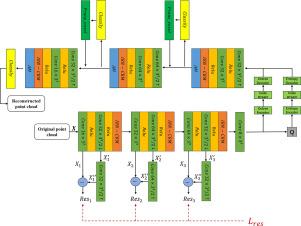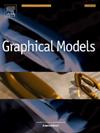Point cloud geometry compression based on the combination of interlayer residual and IRN concatenated residual
IF 2.2
4区 计算机科学
Q2 COMPUTER SCIENCE, SOFTWARE ENGINEERING
引用次数: 0
Abstract
Point clouds have been attracting more and more attentions due to its capability of representing objects precisely, such as autonomous vehicle navigation, VR/AR, cultural heritage protection, etc. However, the enormous amount of data carried in point clouds presents significant challenges for transmission and storage. To solve this problem, this dissertation presents a point cloud compression framework based on the combination of interlayer residual and IRN concatenated residual. This paper deployed upsampling design after downsampled point cloud data. It calculates the residuals among point cloud data through downsampling and upsampling processes, consequently, maintains accuracy and reduces errors within the downsampling process. In addition, a novel Inception ResNet-Concatenated Residual Module is designed for maintaining the spatial correlation between layers and blocks. At the same time, it can extract the global and detailed features within point cloud data. Besides, Attention Module is dedicated to enhance the focus on salient features. Respectively compared with the traditional (G-PCC) and the learning point cloud compression method (PCGC v2), this paper lists a series of solid experiments data proving a 70% to 90% and a 6% to 9% BD-Rate gains on 8iVFB and Owlii datasets.

基于层间残差与IRN级联残差结合的点云几何压缩
点云由于其精确表征物体的能力,在自动驾驶汽车导航、VR/AR、文化遗产保护等领域受到越来越多的关注。然而,点云中携带的大量数据对传输和存储提出了重大挑战。为了解决这一问题,本文提出了一种基于层间残差和IRN拼接残差相结合的点云压缩框架。本文对点云数据进行下采样后的上采样设计。它通过下采样和上采样计算点云数据之间的残差,从而在下采样过程中保持精度并减少误差。此外,设计了一种新颖的Inception resnet - concatated残差模块,用于保持层和块之间的空间相关性。同时,它可以提取点云数据中的全局和细节特征。此外,注意力模块致力于增强对显著特征的关注。与传统的(G-PCC)和学习点云压缩方法(PCGC v2)相比,本文列举了一系列可靠的实验数据,证明在8iVFB和Owlii数据集上的BD-Rate分别提高了70% ~ 90%和6% ~ 9%。
本文章由计算机程序翻译,如有差异,请以英文原文为准。
求助全文
约1分钟内获得全文
求助全文
来源期刊

Graphical Models
工程技术-计算机:软件工程
CiteScore
3.60
自引率
5.90%
发文量
15
审稿时长
47 days
期刊介绍:
Graphical Models is recognized internationally as a highly rated, top tier journal and is focused on the creation, geometric processing, animation, and visualization of graphical models and on their applications in engineering, science, culture, and entertainment. GMOD provides its readers with thoroughly reviewed and carefully selected papers that disseminate exciting innovations, that teach rigorous theoretical foundations, that propose robust and efficient solutions, or that describe ambitious systems or applications in a variety of topics.
We invite papers in five categories: research (contributions of novel theoretical or practical approaches or solutions), survey (opinionated views of the state-of-the-art and challenges in a specific topic), system (the architecture and implementation details of an innovative architecture for a complete system that supports model/animation design, acquisition, analysis, visualization?), application (description of a novel application of know techniques and evaluation of its impact), or lecture (an elegant and inspiring perspective on previously published results that clarifies them and teaches them in a new way).
GMOD offers its authors an accelerated review, feedback from experts in the field, immediate online publication of accepted papers, no restriction on color and length (when justified by the content) in the online version, and a broad promotion of published papers. A prestigious group of editors selected from among the premier international researchers in their fields oversees the review process.
 求助内容:
求助内容: 应助结果提醒方式:
应助结果提醒方式:


